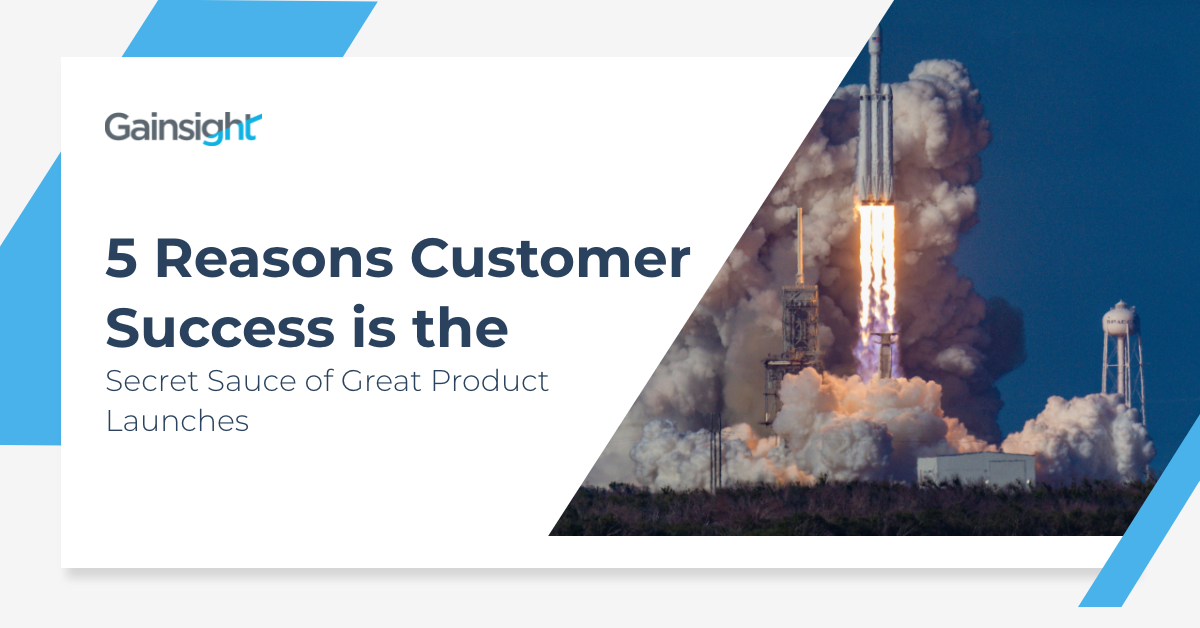At first glance, there isn’t much overlap in product marketing and customer success teams’ day-to-day responsibilities. They usually sit in different areas of the org, report to other functional leaders, and are held to unique success measures.
However, the roles of product marketing and customer success are far more alike than not, and this is most obvious when your team is launching a new product. In fact, in my experience, a close partnership between PMM and CS throughout the product launch process is one of the secrets to a truly exceptional product launch.
Here are five reasons why:
1. The best launches never catch high-value customers or power users off guard
While planning and executing product launches that include a big reveal of new features and functionality is one of the most exciting activities at any company, the same can’t always be said for its customers. Especially among enterprise companies, being surprised by upcoming product changes can be far more detrimental than exciting.
In most software companies, one of product marketing’s primary jobs is launching new features and functionality. And when PMMs plan product launches, they aim to spread the news far and wide. However, great PMMs also know that enterprise accounts must hear about upcoming changes ahead of time and prepare these users for anything that could disrupt their day-to-day work in the product. This is especially true in the B2B space, where most software is mission-critical for customers to succeed in their respective jobs.
Enter customer success.
Customer success teams are perfectly and uniquely positioned to identify the list of customers to notify ahead of an upcoming launch. And, by partnering with customer success, product marketing teams ensure that no product launch ever catches a high-value customer, or power user, off guard. Using a product roadmap tool, PMM and CS teams can securely keep key users aware of upcoming product changes before they’re released. The result? The best of both worlds on launch day: a launch that can go as far and wide as possible, without any potential blowback to the business from VIPs who felt unprepared.
2. The most impactful product launches demonstrate an exceptional understanding of their intended audience
Product marketing drives the messaging and positioning of product launches, and the best messaging and positioning comes from a deep understanding of your customer. There is no one closer to customers—specifically, happy customers that have found success with a given product—than customer success.
The best PMMs know that sharp, impactful messaging and positioning result from several rounds of feedback with multiple stakeholders throughout the business. As customer success team members are uniquely familiar with new customers’ wants and needs, the key insights and perspectives they can provide PMM can mean the difference between good and great messaging and positioning.
If the best product launches demonstrate an exceptional understanding of their intended audience, customer success is an indispensable partner in unlocking this deep level of understanding.
3. Great product launches anticipate potential questions and concerns ahead of time
Product launches will inevitably introduce change. To maintain an active, engaged, and happy user base, it’s imperative to manage this change by properly introducing product changes. One of the most effective ways to do this? Anticipate and prepare for your users’ questions and concerns prior to every launch, and properly enable all customer-facing teams with the appropriate answers before launch day.
In most organizations, the job of internal enablement falls to product marketing, and yet, similar to the above use case, the best PMMs are aware that they alone don’t have the necessary information to anticipate every customer question or concern. There are simply too many different customer types and corner cases. But customer success teams, who engage with these very customers day in and day out, are in the perfect position to help product marketing see around the corners and anticipate all forthcoming launch day questions.
Suppose product marketing is tasked with building exceptional internal enablement materials ensuring customer-facing teams are confident and prepared ahead of launch day. In that case, customer success teams are uniquely qualified to give feedback to sharpen these enablement materials. The end results are launches that are a success for the business and a great experience for customers.
4. The most memorable product launches include customer testimonials
A case study is one of the most powerful ways to add credibility and a social proof point to any product and website. However, even without a launch date looming, they’re one of the most difficult, time-intensive marketing activities to execute. In the PMM world, it’s a running joke how often customer testimonial work is deprioritized due to the amount of up-front coordination required. However, for this very reason, a customer testimonial is one thing that sets great launches apart.
Given the above, it’s no surprise that ahead of significant product launches, customer testimonials are the first workstream to be deprioritized and aren’t completed 99% of the time. And the why is simple: the most time-consuming part of any customer testimonial is finding the right customer to engage with and getting them excited about the opportunity. Product marketers usually don’t have direct, 1:1 channels through which to reach customers, and even if they did, locating the right candidate is like finding a needle in a haystack.
Enter customer success.
By partnering with CS, product marketers not only get help finding and locking in the right customer testimonial candidate, but it allows the customer success team to position this offer in a way that excites customers and makes them feel valued. It’s a win/win for both teams and the customer, with the ultimate result being a truly great and memorable launch.
5. Exceptional product launches include multiple, personalized touchpoints
Another ingredient in every great product launch is a personalized strategy for reaching users through multiple different touchpoints. This should include personal follow-ups with specific users to understand how the new feature or functionality resonated with them. However, the problem with this tactic is twofold:
- It requires easy access to granular product launch analytics showing who did and didn’t act on your announcement comms.
- It’s a complicated process to scale as your user base grows, especially if all launch responsibilities fall to a single team.
As a solution, product marketing can partner with customer success to create a targeted list of high-value customers who are most likely to be impacted and/or excited by whatever you’re launching. Then, subsequent rounds of communication will not only be hyper-targeted but personalized to that specific user and their use case. In my experience, if product marketing teams up with customer success, they can scale this tactic effectively.
Going one step further, if there are specific accounts that your customer success team knows must be made aware of what’s launched (or is about to launch), your teams can even provide a 1:1, “white glove” level of service. LaunchNotes is a popular tool with customer success teams because it allows for a granular level of launch analytics out of the box. So whenever anything is shipped, there’s never any guessing which customers may not have received or engaged with the news and who needs a personalized follow-up from a CS team member.
Closing thoughts
While the roles of product marketing and customer success have fundamentally different charters within an organization, there’s no more powerful combination when it comes to preparing for, and executing, a truly great product launch. And, as evidenced in this piece, if properly engaged, customer success teams might be one of the most underutilized and influential marketing superpowers within your organization.


